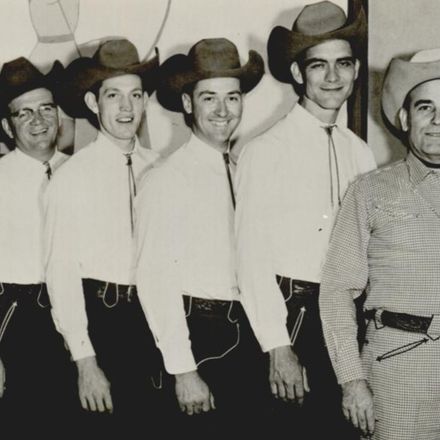City on a Hill
Published April 2020
By Sam Anderson | 27 min read
Richard Williams still plays tennis. This may not be the kind of thing that inspires a breaking news headline these days, but maybe it should, because it is in its way miraculous. Williams is seventy-four years old, and he still plays tennis so regularly and thinks about it so often that when I asked recently how life was treating him, the first thing he said, with deep satisfaction, was, “Good tennis weather today.”
Williams is a survivor of the Oklahoma City Bombing. So it is a miracle that he exists in the year 2020—that he is around to talk about the weather, play a sport multiple times a week, and make good-natured jokes about his declining footspeed. For the rest of his life, he will carry the wounds from that day, internal and external. To hold his tennis racket, for instance, Williams has to build up the handle with overgrips until it’s big enough to fit in his right hand, the fingers of which are bent and curled, up and down, permanently out of alignment. He calls it, affectionately, his “funny hand.”
Williams was one of the countless people whose lives were wrenched suddenly out of alignment on the morning of April 19, 1995. At 9:02 a.m., time froze, and the space of the whole city warped around it. Near the beginning of an otherwise normal workday in the middle of a quiet downtown, a homemade truck bomb ripped through the Alfred P. Murrah Federal Building. The ground shook in neighboring cities; more than three hundred buildings were damaged or destroyed. Though the blast took only a fraction of a second, it killed 168 people and injured many hundreds more. Immediately, the attention of the entire world flowed into Oklahoma City. The tragedy, for better and for worse, came to define the place. Twenty-five years later, we still struggle to understand the damage—how deep it goes, how many lives it altered, and how the city and its people built themselves back up around the shape of so much absence.
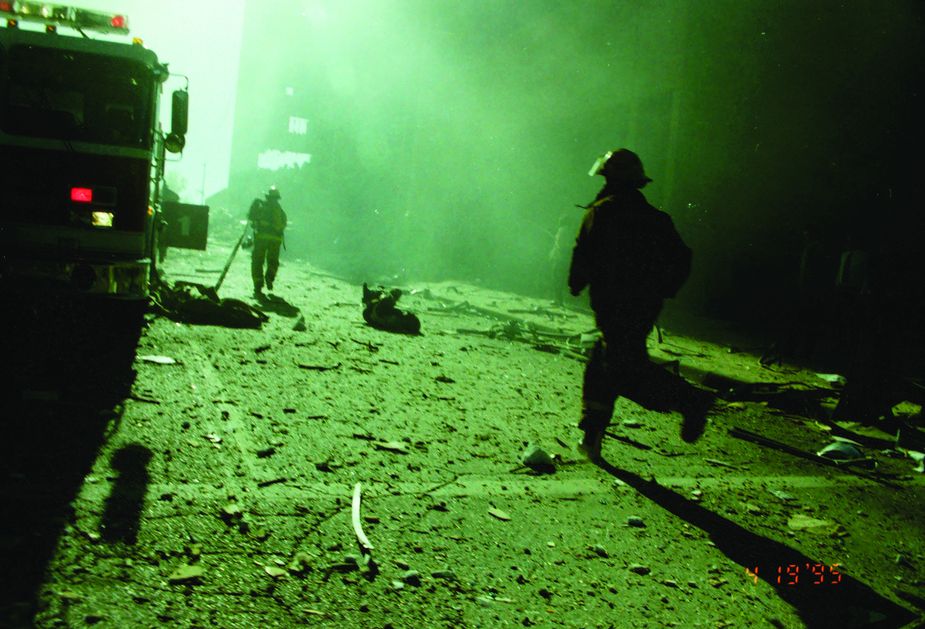
First responders were among the first to make a visual record of the Oklahoma City Bombing. Thousands of their images remain in the archives of the Oklahoma City National Memorial & Museum. Here, members of the Oklahoma City Fire Department run toward the Murrah Building. Photo by Oklahoma City Fire Department/Oklahoma City National Memorial & Museum.
Richard Williams now lives in Houston, but it doesn’t take much to bring his thoughts back to that morning in Oklahoma City. He might see a news article about one of the terrorists. He might stumble across an artifact from the Murrah Building in his house—he has donated many to the Oklahoma City National Memorial & Museum, but he likes to keep some close. Or it might come up on the tennis court, when a new opponent asks Williams an innocent question—where he’s from, what he did for a living—and the story of that day will find its way out. Although he never volunteers his memories of the bombing, he’s willing to talk if someone asks.
Williams’ left hand, the non-funny one, emerged from the bombing just fine. Today, it is absolutely normal—fingers aligned nice and strong. But this is the thing about that funny hand: All these years later, after multiple surgeries and physical therapy, after exercises he still has to do, the injured hand not only has regained its original strength—it has surpassed it. While it might look unusual, the funny hand now is stronger than the normal one. All of that unthinkable damage, in the end, after many years of recovery, after a quarter century of grinding work, turned out to make the thing better than it might otherwise have been.
Twenty-five years is, depending on how you look at it, a very long time or a very short one. In the grand scheme of the universe, of course, it is nothing. For an ancient city like Paris, Beijing, or Mumbai, a quarter of a century is hardly more than a moment.
But Oklahoma City is not like other cities. Among its unique qualities, it has a special relationship to time. No other major American city was born, as it was, in a single day—April 22, 1889, when thousands of settlers came rumbling over the plains to claim land in the middle of Indian Territory. Since then, no other city has transformed and reinvented itself so many times in such a short period. At various times, Oklahoma City has demolished and rebuilt much of its downtown and expanded its outer borders exponentially. It has turned itself into a brand-new city many times over—and done so in roughly the amount of time it would have taken a normal city to start holding meetings about possibly beginning to file the paperwork. In Oklahoma City, twenty-five years is a whole history unto itself.

The Oklahoma City Police Department captured this aerial view of the Murrah Building shortly after the bombing. Photo by Oklahoma City Police Department/Oklahoma City National Memorial & Museum.
In October 2019, I went to City Hall to speak with Mayor David F. Holt. The MAPS 4 process was ramping up, and a city councilperson had dropped by, so I waited outside his office, inspecting glass cases that held pieces of history: black-and-white photos of mustachioed men who came in the Land Run, a brick from the groundbreaking of the Chickasaw Bricktown Ballpark, Thunder paraphernalia. It was a compressed narrative of Oklahoma City with heavy emphasis on the recent renaissance. That narrative carried over into Holt’s office. A framed Thunder cartoon drawn by the Japanese superfan Nanae Yamano hung on one wall—evidence of a global reach the city never could have dreamed of back in the 1990s. Near the window was a street sign autographed by Kings of Leon, who performed at the opening of Scissortail Park, a grand public space in a part of town long dismissed as a wasteland.
Holt, surrounded by such celebratory mementos, pointed out how unlikely all this progress seemed back in 1995. The bombing hit at the end of multiple waves of civic misfortune: the oil bust and bank failures of the early 1980s, widespread unemployment, decaying infrastructure. After the destruction that had come with urban renewal, downtown felt empty, desolate, ruined. In 1991, United Airlines rejected Oklahoma City’s bid for a major repair facility because, executives said, they couldn’t imagine making their employees live there. A terrorist attack, in a place already so devoid of public life, seemed like it might be too much to take. It was easy to imagine a rapid decline.
“There would still be people living here,” Holt says. “We weren’t going to get sacked by the Goths or something. But if we had dramatically decreased in population and economic activity, nobody would have been surprised. At that point, it would have been reasonable to predict that this city was just dying. And that’s not what happened at all.”
Instead, the recovery from the bombing fused with MAPS—the experimental tax program that had passed in 1993—to propel the city to its current rebirth: a thriving metropolis with nationally renowned restaurants, upscale downtown hotels, multiple hives of artistic activity, craft brewing, and a high-powered soap opera of an NBA team.
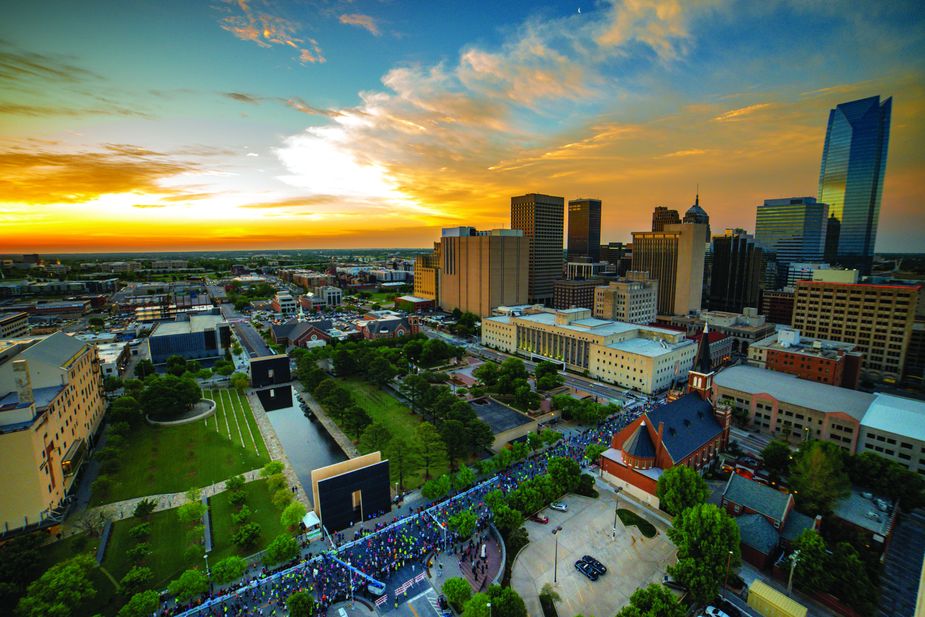
An eastern view on the morning of the Oklahoma City Memorial Marathon on April 28, 2019. Photo by Oklahoma City National Memorial & Museum.
“Oklahoma City is unrecognizable from 1995 to 2020,” Holt says. “We didn’t just fix things back the way they were—we built a much, much better city. There is really no city that has made more progress in the last twenty-five years. Population has significantly grown, economic output has significantly grown, quality of life has significantly improved. Young people are moving here. Suddenly, we’re one of the feel-good stories of the nation. Obviously, a big part of that narrative was the idea that we were recovering from the bombing. So in its horrific way, the bombing gave us something to react positively against and build a better city out of the wreckage. I’m honored to be the mayor of a city that has had such a wonderful reaction to such an evil event.”
At forty, Holt is a young mayor, and he has a strong sense of public narrative. I asked what twenty-five years means to him.
“It means that there are people, basically thirty and younger, who have no actual memory of the event,” he says. “That is a significant part of the world population. So it is rapidly moving into history.”
This presents a new challenge. More than sixty percent of Oklahoma City’s current population either was not born or not living here when the bombing happened. It used to be that April 19, 1995, overwhelmed everything else. But for new generations, reality has moved on. The bombing now is something people have to be taught.
“I suspect there will be a significant amount of national attention paid to the twenty-fifth anniversary,” Holt says. “And I equally suspect that it will be the last time that there’s that volume of national attention paid to our anniversaries here. It’s shifting toward a historical event.”
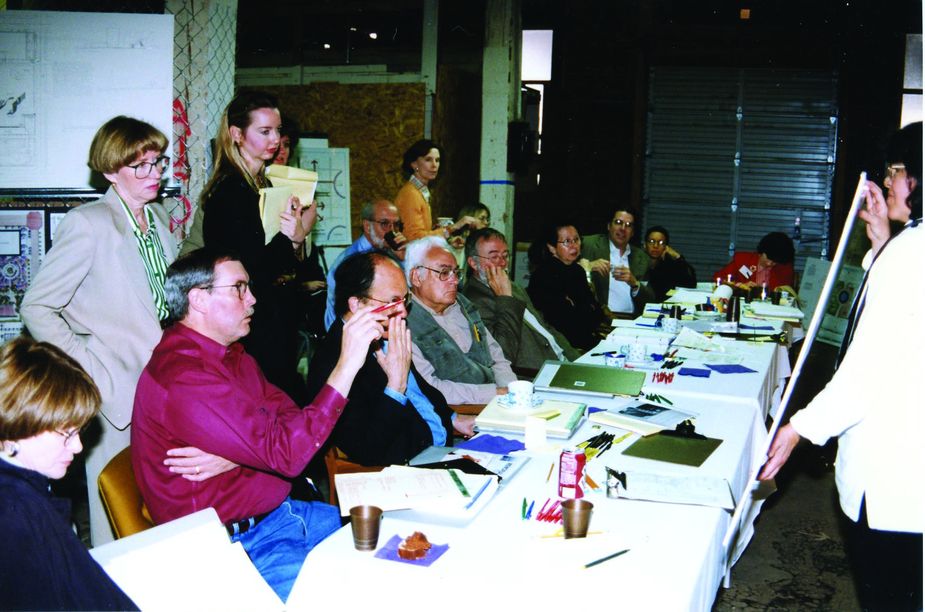
Bombing survivor Richard Williams, in red, was a member of the committee that made selections for the international design competition that chose the final form the Oklahoma City National Memorial & Museum would take. Photo by Oklahoma City National Memorial & Museum.
But, he says, the lessons of the day persist.
“We have a story to tell that is relevant eternally,” he says. “It goes beyond the specific events that were committed in 1995. This is a story about what happens when people dehumanize each other, what happens when people act outside the democratic process. What happens when people commit acts of political violence. This should be a sacred place in American history, much like a Civil War battlefield, where people come, now and forever, to be reminded that it is not a solution to our problems to kill each other. It’s incumbent upon us to make the lessons timeless.”
From her office window at the Oklahoma City National Memorial & Museum, executive director Kari Watkins can see evidence of the same downtown resurgence Mayor Holt was talking about. There is the Regency apartment building, damaged in the bombing but now renovated and home to new generations of residents. Further off, there is the distinctive sign of Midtown, the flourishing neighborhood in which Watkins’ nephews have opened an ice cream shop that sells gourmet flavors garnished with avocado or breakfast cereal.
Watkins was the first employee hired at the Memorial. Despite being busy trying to finish her MBA, Watkins says she was honored to take the job, which at the time was, ostensibly, a twenty-hour-a-week gig. Instead, it immediately consumed her life—as it did for all involved. In the years since, Watkins has met almost everyone affected by the blast, from rescue workers to the family of those killed. She has widened the circle of those affected by the bombing, sharing meals with them and tracking their lives over the decades as they remarried and started new families.
“I’m kind of amazed by how many people are able to do that,” she says.
Now, Watkins is busy with the logistics of planning the anniversary, tasks that are mundane—re-caulking the Reflecting Pool, putting in a new steel-and-fiberglass support for the Survivor Tree—and profound, like gathering the ever-widening group of victims and their families. The years, she told me, have flown by.

The Murrah Building was demolished on May 23, 1995. Pieces of salvaged granite were used to create Survivor Wall in the Outdoor Symbolic Memorial. Photo by Oklahoma City Fire Department/Oklahoma City National Memorial & Museum.
“When we built this place, we said, ‘Someday, we’ll teach a generation of kids who weren’t alive at the time,’” she says. “It seems like that came really fast.”
Watkins has two teenage children, and they have grown up entirely in the new Oklahoma City. They remember nothing before the great restaurants, fancy ice cream, artsy T-shirt shops, and NBA superstars. More than ever, this is the essence of Watkins’ job: to help people remember.
“This city was rebuilt around an enormous loss,” she says. “And I don’t want people to ever forget that loss. Those people should be remembered, and their stories should be told. They were doing great things that day. Either they were doing their job and doing it well, or they were using a service of the government, which we’re all entitled to. And McVeigh and his cohort decided to change their world. As we start to remember twenty-five years—while it is hard, and it is gut-wrenching—it’s time to make sure everyone knows the story again.”
So let’s make sure we know the story. April 19, 1995, was an ordinary Wednesday in Oklahoma City. Cool weather, clear skies, chance of evening storms. What made it extraordinary was the presence of Timothy McVeigh, a Gulf War veteran, Second Amendment activist, and white nationalist hopped up on conspiracy theories. McVeigh loathed the United States government, and he wanted to try to take it down. So that morning, he drove a rented Ryder truck into the center of Oklahoma City. He and Terry Nichols had loaded it with barrels of fuel and ammonium nitrate, turning it into a rolling bomb. Just before 9 a.m., McVeigh parked directly in front of the Alfred P. Murrah Federal Building and lit the fuse. He was not an Oklahoman. He had no connection to anyone in Oklahoma City. He had chosen the place because its federal building was relatively exposed—an easy target—and it housed some of the agencies he most wanted to hit, including the Bureau of Alcohol, Tobacco, and Firearms and the FBI. As he walked to his getaway car, McVeigh left behind him a tragedy beyond understanding.
Less than seventy-five feet away from the parked Ryder truck was the office of Richard Williams, the tennis player with the funny hand—though in that moment, both hands were normal. Williams was principal assistant manager of all twenty federal buildings in the state, including the Murrah Building, so he knew the place inside and out. He had watched it get built and, for nearly twenty years, had been battling its quirks every day. The building was not only an architectural showpiece—nine stories of poured concrete and granite curved at the edges with a sheer glass wall on the north—it also was a technological marvel. Many of its systems were computerized, and there was an automatic flagpole out front. For the 1970s, this was futuristic stuff. Williams’ job was to make sure all those bells and whistles actually worked, to make the grand theory of the building match up with its daily reality. Maintaining a comfortable temperature was an ongoing challenge—office workers tried to fool the thermostat by holding ice cubes near it to get more heat when it was cold and lighters to get more air conditioning when it was hot. The flagpole’s motor would snag the flags’ fabric, suck it in, and chew it up.
Williams knew almost everyone in the building, from the lifelong bureaucrats to the people running the snack bar. One of the highlights every year was Halloween, when the kids would come trick-or-treating through the building. In the mornings, he liked to watch through that huge northern wall of glass as workers parked in their favorite spots and walked in.
On the morning of April 19, 1995, Williams had just finished a meeting. He was standing in his office, chatting with a colleague. That’s the last thing he remembers.
After the blast, he was buried under rubble. He thinks that, at some point, a first responder saw his hand—he has a vague memory of a rescue worker saying, “Hold on, I’ll be back.” He was in the hospital by 9:35 a.m. A policeman had dug through the debris, uncovered Williams, and carried him out of the building like a baby. His injuries were gruesome; his ear had been torn off, one leg sliced open, his face fractured, and his right hand crushed. It took more than 150 stitches to begin to repair the damage. He was one of the lucky ones.
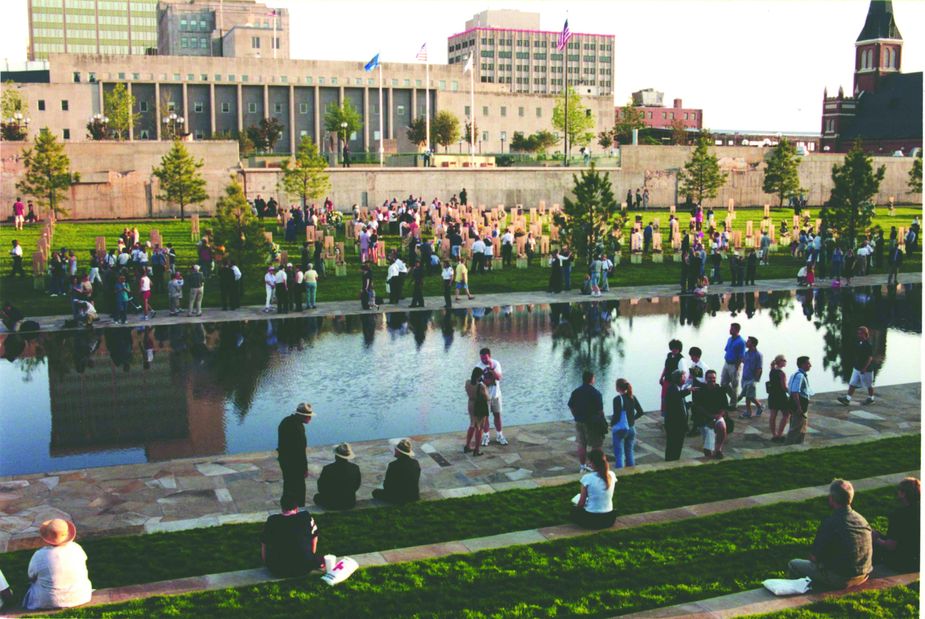
Thousands of people came to the opening of the Oklahoma City Memorial & Museum on February 19, 2001. Photo by Oklahoma City National Memorial & Museum.
This is one of the defining paradoxes of the bombing: It took no time at all—half a second—yet there is an eternity inside it. This is the mission of the Memorial: to preserve that eternity. It is bracketed by two Gates of Time—9:01, the minute before the bombing, and 9:03, the moment after—within which the physical space of the tragedy has been retained but also transformed. Northwest Fifth Street, where McVeigh drove his truck, now is the Reflecting Pool. Inside the old footprint of the Murrah Building stand 168 chairs, each engraved with the name of a victim.
In the aftermath of the bombing, something simple but extremely powerful happened that would redefine Oklahoma City in the eyes of the world: People helped each other—everywhere, visibly, abundantly. Inside the ruined building, coworkers on the brink of death tried to help others on the brink of death. Police, firefighters, FBI agents, nurses, doctors, and journalists streamed into the disaster zone to practice their skills under nearly impossible circumstances. From all across the city, ordinary citizens drove in supplies: boots, bandages, umbrellas, jackets, food. Oklahomans showed a powerful communal compassion that seemed to have no limit. As rescuers searched the rubble, the death toll climbed, and the extent of the damage became horribly clear, that compassion would be one of the things that got the city through.
The glass in his body alone would guarantee that Richard Williams never forgot. His office was right next to the Murrah Building’s northern windows, and the bomb turned that sheer wall of glass into a hurricane of shards that rained from the sky for many minutes after the blast. In the hospital, Williams had so much pulverized glass in his hair it looked like glitter. A nurse had to try to comb it out without snagging any of the twenty staples in his scalp. One specialist removed shards of glass lodged in his ear canal. Williams still keeps in his home a large piece of glass that was removed from his cheek two years after the bombing. It is, he says, about twice the size of a diamond in a nice engagement ring. So much glass went into Williams that there was no way for surgeons to remove it all. He had to wait for his body to do most of the work. For years, pieces of glass have been working their way toward the surface, looking for a way out. Even today, he can still feel a piece of glass above his right eye. It was there as we talked; he touched it.
“It’s just there,” he says. “Doesn’t hurt. Doesn’t bother me. I can feel it, almost on a regular basis. But I don’t think about it, and I don’t worry about that kind of stuff. I really don’t. After I got to the hospital, the most important thing for me was getting back to doing something. Because if I sat around and felt sorry for myself or sat and immersed myself in it too much, I don’t know which direction I would have gone.”
So he got back to work as soon as he could, part-time, just forty-three days after the bombing. In the meantime, he used his knowledge of the Murrah Building to advise those carrying out the demolition of its wreckage. Eventually, he started playing softball again—then tennis. He volunteered to be on every possible committee having to do with the Memorial. He still goes back to the site frequently, and he still thinks about the bombing pretty much every day.
I spoke to Williams in October. It was nearly Halloween, and the holiday makes him think about the kids in the Murrah day care center, the way they used to trick or treat from office to office. He does not like the word closure. The best you can do, he says, is find a new normal. This means acknowledging the past yet moving forward.
“I will never draw that line and say, ‘That’s it, I’m over this, I’m going to forget it,’” Williams says. “But also, I will never draw that line that says, ‘This is the only thing that’s going to define who I am.’ It’s a fine line. You can move on but never forget.”

